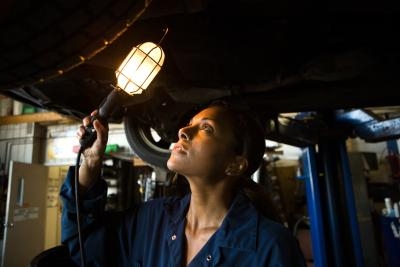
Beyond routine maintenance like oil changes and tire rotations, regular inspection of vehicle component systems will help ensure proper long-term operation. One important system to keep an eye on is a vehicle's front end. Comprised of parts including ball joints, steering stabilizers and center links, the front end plays a vital part in the overall handling of a car. By regularly checking front-end components for wear and tear, vehicle owners will be able to quickly diagnose and repair worn parts before a major breakdown occurs.
Raise the vehicle on an automotive hoist or on jack stands placed on a hard, level surface. Roll underneath the vehicle on an automotive creeper and locate the upper and lower ball joints on either side of the vehicle's control arm. Look for a wear indicator on the ball joints and check the level of wear. If no wear indicator is present, utilize a dial indicator to measure the radial and axial movement of the joints in comparison to the recommendations within the vehicle's owner's manual.
Lower the vehicle back to the ground and continue your inspection with the vehicle on a level surface under a normal load. Check the center link by asking a partner to turn the vehicle's steering wheel as you inspect the sockets connecting the center link to the vehicle's tie rod ends. Look for vertical and lateral movement at the socket. Any movement or "play" in the socket indicates excessive wear.
Check the pitman arm by having a partner continue to move the steering wheel from side to side. Look for movement in the sockets connecting the pitman arm to the center link and the steering output shaft. Any lateral or vertical movement at the sockets indicates the need for replacement.
Locate the steering stabilizer that is connected at the steering linkage to the vehicle's frame. Look for signs of fluid leaking from the stabilizer. Check the adjusting sleeve that connects the inner and outer tie rod ends by looking for signs of rust or thread wear.
Inspect all of the bushings contained within the front end of the vehicle. Multiple parts including sway bars, struts and control arms will feature bushings to absorb shock. Take note of any cracked or oil-soaked bushings that may be in need of replacement.
Visually inspect the inner and outer tie rod ends while an assistant turns the vehicle's steering wheel back and forth. Look for movement in the connection sockets at the center link and steering arm. Vertical or lateral movement indicates a need for replacement. Also check the dust boots on each tie rod end for tears or cracks. If a boot is missing or damaged, replace it as soon as possible.
Replace any worn components to ensure safe handling and proper tire wear, and to avoid excessive wear to other front-end components.